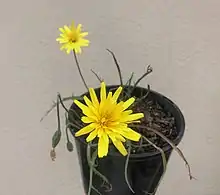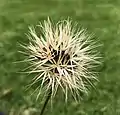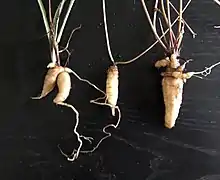Microseris walteri
Microseris walteri is an Australian perennial herb with yellow flowers and edible tuberous roots, and one of three plants known as murnong or yam daisy along with Microseris scapigera and Microseris lanceolata.[3][2]
| Microseris walteri | |
|---|---|
 | |
| Scientific classification | |
| Kingdom: | Plantae |
| Clade: | Tracheophytes |
| Clade: | Angiosperms |
| Clade: | Eudicots |
| Clade: | Asterids |
| Order: | Asterales |
| Family: | Asteraceae |
| Genus: | Microseris |
| Species: | M. walteri |
| Binomial name | |
| Microseris walteri | |
| Synonyms[2] | |
| |
The plant is found in southern parts of Australia, including Victoria, NSW, ACT, SA, WA and Tasmania. In Victoria, the plant is widespread and occupying a wide range of habitats, particularly dry open forest.[4]
Botanical naming
For more than 30 years Murnong was named as Microseris sp. or Microseris lanceolata or Microseris scapigera. Royal Botanic Gardens Victoria botanist Neville Walsh clarified the botanical name of Microseris walteri in 2016 and defined the differences in the three species in the table below.[4]
| Feature | M. walteri | M. lanceolata | M. scapigera |
|---|---|---|---|
| Roots | single fleshy root expanding to a solitary, napiform to narrow-ellipsoid or narrow-ovoid, annually replaced tuber | several fleshy roots, cylindrical to long-tapered, branching just below ground-level | several cylindrical or long-tapered, usually branched shortly below leaves |
| Fruit (Capsela) | usually less than 7mm long | usually less than 7mm long | mostly 7–10 mm long |
| Pappus bristles | c. 10 mm long, 0.5–1.3mm wide at base | 10–20 mm long, c. 0.3–0.5 mm wide at base | 30–66 mm long |
| Joined petals (Ligule) | usually more than 15mm long | usually more than 15mm long | up to 12mm long |
| Origin | lowlands of temperate southern WA, SA, NSW, ACT, Victoria and Tasmania | rarely on basalt soils; alpine and subalpine NSW, ACT and Victoria | mostly from basalt plains of western Victoria and elevated sites in Tasmania |
| Taste of roots | sweet-tasting, both raw and cooked | bitter, slightly fibrous and not particularly palatable | slightly fibrous, and slightly, but tolerably bitter |
Biological descriptions
Microseris walteri has the form of a tufted rosette of toothed lanceolate leaves.
The flower appears in Spring, which is a yellow head of florets, similar to flatweed (Hypochaeris radicata) or dandelion (Taraxacum). The flower stalk is pendulous before flowering, becoming erect for flowering to attract pollinators and again with the ripening of the seed head. The seed heads ripen to a cluster of fluffy, tan achenes, each having a crown of fine extensions called a pappus. The seeds are dispersed by wind.[5]
The plant usually grows a single tuber each season. There is a wide variation in shape and size of tubers between plants from different habitats in the Victoria. Those from northwest Victoria have probably the longest tubers. A rare form from the volcanic plain (Woorndoo area) has a stocky, sometimes few-branched, but apparently perennial tap-root. [2]
Gallery
 Microseris walteri flower
Microseris walteri flower Flower measurement
Flower measurement Seed clock
Seed clock Roots
Roots Seed comparison, from left to right: Microseris scapigera, Microseris walteri and Microseris lanceolata
Seed comparison, from left to right: Microseris scapigera, Microseris walteri and Microseris lanceolata
Cultivation and uses
The edible tuberous roots of murnong plants were once a vitally important source of food for the Indigenous Australians. In the south-eastern parts of Australia, Indigenous women would dig for roots with a digging stick, also known as a yam stick,[5] and they would carry the roots in a dillybag. The practice of digging for tubers and leaving part of the tuber, meant the soil was tilled and caused more plants to grow. Murnong was cooked by placing a dillybag of tubers onto an earth oven for roasting. The taste of the cooked tuber is described as 'sweet with a flavour of coconut'.[6][7]
The introduction of cattle, sheep and goats by immigrating early–colonialist Europeans led to the near extinction of murnong, with calamitous results for first Australians' communities who depended upon murnong for a large part of their food. [3]
References
- Gandoger, Michel (1918). "Sertum plantarum novarum". Bulletin de la Société Botanique de France. 65 (52).
- "Microseris walteri Gand". VicFlora: Flora of Victoria. Royal Botanical Gardens Victoria. Retrieved 31 August 2020.
- Gott, Beth (1993). "Use of Victorian plants by Koories". In Foreman, Don B.; Walsh, Neville G. (eds.). Flora of Victoria. Vol. 1. Melbourne: Inkata Press. pp. 195–211. ISBN 978-0-909605-76-6.
- Walsh, Neville (2016). "A name for Murnong (Microseris: Asteraceae: Cichorioideae)" (PDF). Muelleria. 34.
- Gott, Beth (1983). "Murnong – Microseris scapigera: A study of a staple food of Victorian Aborigines". Australian Aboriginal Studies. 2: 2–17.
- Pascoe, Bruce (2014). Dark Emu, Black Seeds: Agriculture or Accident?. Magabala Books. pp. 22–24. ISBN 978-1-922142-43-6.
- Maiden, Joseph H. (1889). The Useful Native Plants of Australia : Including Tasmania. Sydney: Turner and Henderson. p. 45.
'Murr-nong,' or 'Mirr n' yong,' of the aboriginals of New South Wales and Victoria. The tubers were largely used as food by the aboriginals. They are sweet and milky, and in flavour resemble the cocoanut.
External links
- Photographs of herbarium type specimens:
- "Victoria, Sandringham, Sept. 1900, C.Walter s.n." LY 0009479 (type for M. walteri Gand.)
- "W. Australia, J.Drummond 5th Coll., 366" K000796797; West Austr. Maxwell MEL 64832, MEL 64833 (isotypes) (for Microseris forsteri var. subplumosa Benth.)